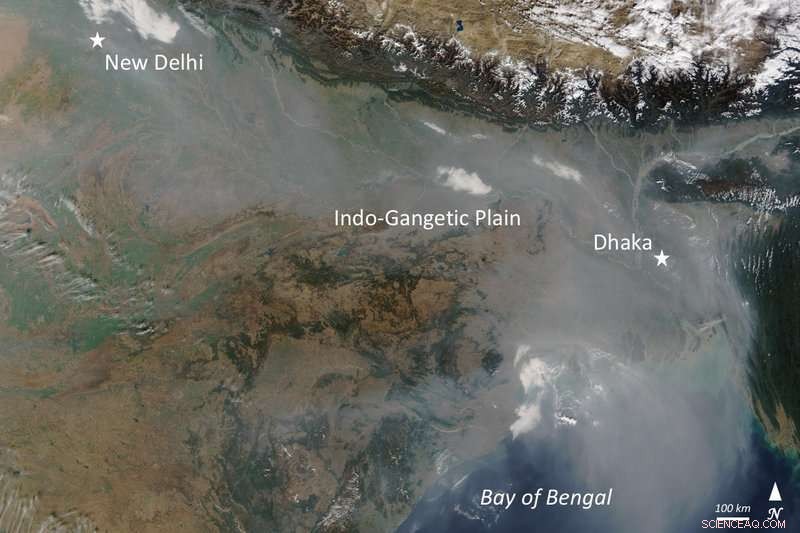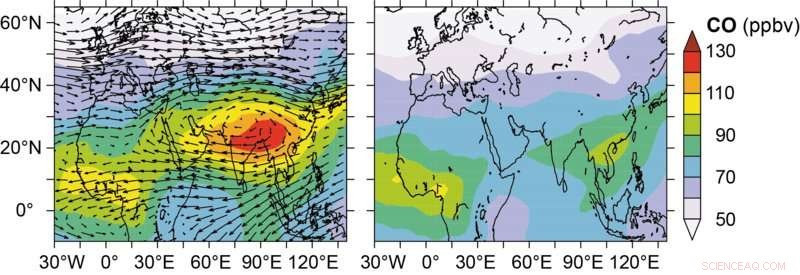
Un'enorme nuvola di inquinamento sull'Asia meridionale:l'Atmospheric Brown Cloud viene creata ogni anno durante i mesi invernali dalla combustione di biomassa e combustibili fossili. Credito:NASA, Jeff Schmaltz, LANCE/EOSDIS Risposta rapida
Lo stesso fenomeno si ripete ogni anno. Durante la stagione secca, in inverno, bruciare combustibili fossili e biomassa nell'Asia meridionale crea un'enorme foschia di inquinamento:l'Atmospheric Brown Cloud. Come e perché scompare non appena inizia la stagione delle piogge in primavera è stato ora chiarito da un team internazionale di scienziati guidati dal Max Planck Institute for Chemistry. Il risultato è che le correnti ascensionali temporalesche, fulmini e reazioni chimiche aumentano il potere autopulente dell'atmosfera, permettendo agli inquinanti atmosferici di essere lavati via efficacemente dall'aria. Però, gli inquinanti che non vengono eliminati vengono trasportati nell'alta troposfera dal monsone e poi diffusi in tutto il mondo.
Nessun fenomeno meteorologico definisce l'Asia meridionale quanto il monsone:questo enorme sistema di circolazione porta alla siccità in inverno ma porta a intense precipitazioni in estate. Il monsone estivo è creato dal riscaldamento delle masse d'aria sul subcontinente indiano e dall'aumento dell'aria calda. Di conseguenza, l'aria umida dell'oceano viene aspirata e fluisce sulla terraferma verso l'Himalaya. Nubi temporalesche profonde producono pioggia sulla regione per mesi, garantire l'approvvigionamento idrico e salvaguardare i raccolti.
I ricercatori atmosferici hanno a lungo sospettato che le masse d'aria in aumento trasportino anche l'inquinamento in alto nell'atmosfera, anche sopra le nuvole di pioggia. "Abbiamo anticipato che gli inquinanti gassosi e particolati vengono trasferiti in un anticiclone, un'enorme circolazione di venti in senso orario, che si forma sopra le nuvole sopra l'Asia meridionale a causa della convezione temporalesca, "dice Jos Lelieveld, Direttore presso l'Istituto Max Planck per la chimica. geograficamente, i paesi del Bhutan, Nepal, Birmania, Bangladesh, Tibet, India, Sri Lanka, Pakistan e Afghanistan fanno parte dell'Asia meridionale. In questa regione, Le emissioni di ossido di azoto e anidride solforosa derivanti dalla combustione di carbone e altri combustibili fossili sono aumentate del cinquanta per cento negli ultimi dieci anni. Però, la nuvola di inquinamento è alimentata anche da altre fonti, in particolare la combustione della biomassa da parte della grande popolazione della regione.
Il monsone trasporta gli inquinanti atmosferici e li elimina
La prova che il monsone dell'Asia meridionale effettivamente trasporta inquinanti attraverso lo strato di nubi fino alla stratosfera è stata ora fornita da un'elaborata spedizione con il velivolo di ricerca HALO:nel 2015, l'Istituto Max Planck per la chimica, insieme ai colleghi del Forschungszentrum Jülich, l'Istituto di tecnologia di Karlsruhe e il Centro aerospaziale tedesco (DLR), ha lanciato la missione "Oxidation Mechanism Observations" (OMO). "I nostri voli di ricerca hanno rivelato che il monsone rimuove efficacemente anche gli inquinanti dall'atmosfera, " ha affermato il capo spedizione Lelieveld. Gli inquinanti vengono trasportati in alto dalla superficie e rapidamente convertiti in composti che vengono rimossi più facilmente dalla pioggia.
Lo studio del team scientifico ha così scoperto la virtù del monsone, ma anche il suo lato negativo:una grande proporzione degli inquinanti dell'Asia meridionale si sposta sopra le nuvole dei monsoni nell'anticiclone. Lì si accumulano e vengono poi distribuiti in tutto il mondo. Per esempio, quasi il dieci per cento delle emissioni di anidride solforosa dell'Asia meridionale raggiunge la stratosfera, che a sua volta ha effetti sul clima e sullo strato di ozono. Il monsone quindi non rappresenta solo un tipo di efficiente lavatrice inquinante, ma contemporaneamente contribuisce all'inquinamento atmosferico globale.
HALO rivela le fonti di inquinamento atmosferico e i processi di degrado
Gli scienziati hanno ottenuto questi risultati dalle misurazioni nell'anticiclone:in luglio e agosto hanno volato fino a 15 chilometri nel deflusso dei monsoni, tra il Mediterraneo orientale e l'Oceano Indiano, and analyzed the composition of the atmosphere with the research aircraft HALO. They passed over regions in the Middle East, the Mediterranean and North Africa to investigate the extent of the phenomenon.

Modelling results illustrate atmospheric pollution over South Asia. The left figure shows carbon monoxide emissions (CO) at an altitude of 12 to 17 kilometres, on the right is the same visualization but without emissions from South Asia. The figure on the left also shows the winds over the region, clearly revealing the anticyclone created by the monsoon. Credit:MPI for Chemistry
During the survey flights, they identified numerous chemical compounds in order to understand the sources of atmospheric pollution and the chemical processes in the atmosphere:sulphur dioxide and nitrogen oxides, ozono, aerosol, chlorine-containing molecules, hydrocarbons and their degradation products.
More carbon monoxide and sulphur dioxide, but also more hydroxyl
Per esempio, the measurement flights revealed that carbon monoxide and sulphur dioxide concentrations within the anticyclone were significantly increased compared to outside. "The large amounts of sulphur dioxide originate from combustion processes by human activities and are much higher than natural background concentrations, " says atmospheric researcher Hans Schlager of the DLR. This, a sua volta, means that a substantial proportion of atmospheric pollution is transported to altitudes up to 15 kilometres. Inoltre, the researchers were able to demonstrate that India represents a significant source of pollutants. It was previously assumed that much of the emissions come from China, because the monsoon's area of influence extends as far as East Asia.
"We also analysed the levels of hydroxyl radicals and found significantly higher concentrations within the anticyclone than outside it, " relates Max Planck researcher Hartwig Harder, who was present during the entire expedition. The hydroxyl molecule (OH) is better known as the atmospheric cleansing agent because it is highly reactive and efficiently oxidizes pollutants. Chemically, this has two effects:on the one hand, their solubility and thus their ability to lock on to existing airborne particles change, making them easier to wash out of the atmosphere by precipitation. D'altra parte, the oxidized molecules can combine to form new aerosols. Because the anticyclone expands widely and disperses the particles, this effect can impact the global climate.
More atmospheric cleaners thanks to lightning
The atmospheric cleanser OH primarily forms when ozone and water are broken down by sunlight. Once the radical has reacted with pollutants, it is generally lost. Però, if nitrogen oxides are present, it is recycled and can purify repeatedly, explains the atmospheric chemist Andreas Hofzumahaus of Forschungszentrum Jülich. Nitrogen oxides are formed not only by the combustion of diesel fuel, but also by lightning in the atmosphere. Because lightning frequently occurs during monsoon thunderstorms, the self-cleaning power at 15 kilometres altitude is maintained despite the atmospheric pollution. According to the scientists, even much more OH is recycled than is primarily formed.
This means, poi, that the monsoon weather phenomenon not only pumps pollutants high into the atmosphere, but simultaneously provides a cleaning mechanism to remove some of those pollutants again.
This explanation was confirmed by the results of an established numerical model system, which computes the chemical processes in the atmosphere globally. Based on this model, it is possible to determine, tra l'altro, the concentrations of individual chemical compounds such as carbon monoxide, diossido di zolfo, idrocarburi, nitrogen oxides and those of the OH radical – verified based on the measurements. The OH decreases by a factor of two to three if the scientists do not take into account the nitrogen oxides produced by lightning in the model.
Because it can be assumed that pollutant emissions in the region will continue to increase in future years, the researchers headed by Jos Lelieveld are interested in how the two faces of the Janus-headed South Asian monsoon will develop in the future:Will the cleaning and transport mechanism continue to exist side by side or will they be tilted in one direction or the other?